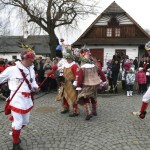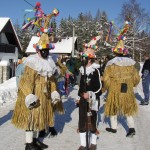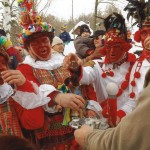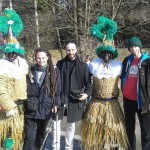A travel into the most traditional carnival of Bohemia
Under a pale mid-February sun, masks are gathered, the processions are formed, giving life to a musical band. The cold stings, but the spirits are already buoyed by generous doses of slivovice, even though it is only the first morning. The bright colours of the masks and the incipient noises contrast with the uniform white of the snow that blankets the village, and with the silence of the countryside surrounding it.
The parade of masks and the throng of curious bypassers, and visitors move, twisting through the serpentine streets of the village, with processions of masks formed by distinct groups visiting the homes in the neighborhood. One group, belonging to the “Turks”, is devoted solely to dance, the traditional kolečko. Others however, like the “Chimney Sweeps”, enter houses and interact with the owners, thus leading to songs and dances in honour, and for the good fortune of the house and the family living there. In return, the collecting masks receive portions of traditional koblihy (jam donuts), pancakes, sandwiches and koláčky (baked pastries). Obviously, one does not skimp on the vodka and particularly not on the slivovice, in order to soothe the infirmities of age, to contrast the cold of winter and warm up temperaments. Meanwhile, the “Mare” and the “Gypsy” roam the neighborhood, lending themselves to a thousand jokes, while the equally traditional masks of the “Bear” and the “Man of Straw” seem more interested in annoying (in a friendly way) the young women of the village. When the procession comes across a girl or a young mother from the area, it is actually a habit to reserve a special treat for them, mimicking acts which are not exactly chivalric, and indeed sometimes even obscene, but all with good intentions, as the natives say, and in order to assure them health and fertility.
While these various actions take place in the same neighborhood, the band formed by the few, typical elements of popular local bands, play the traditional ballads like the famous “Masopust držíme” (“Let’s celebrate the Masopust”).
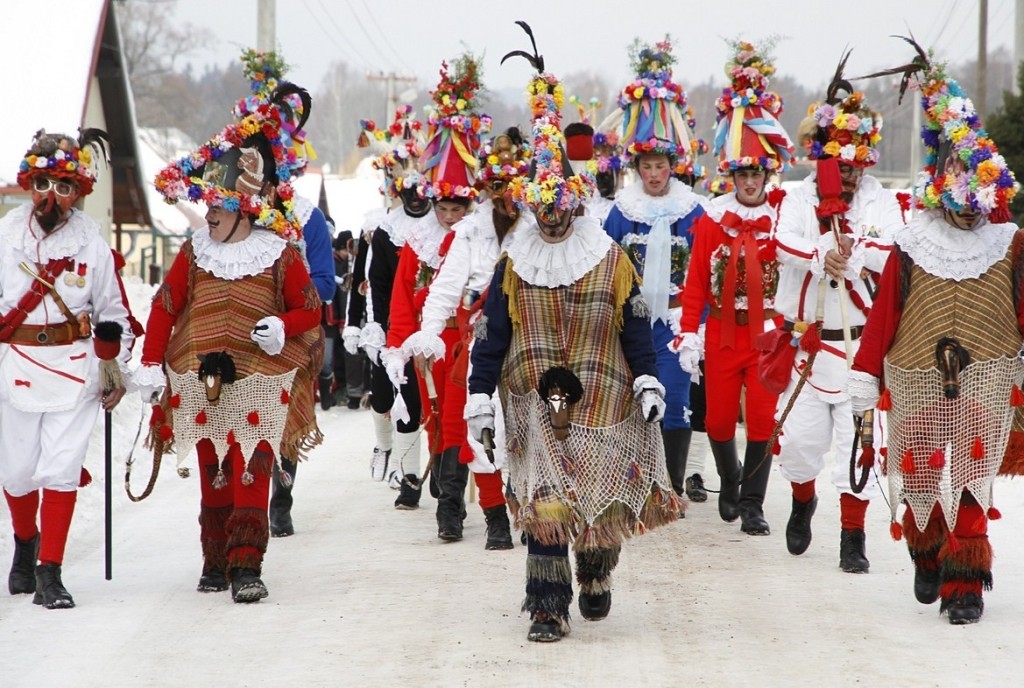 The atmosphere of fun and transgression is palpable and engaging. Everyone, from locals to curious visitors from neighboring villages, and tourists, are involved in the pranks, dancing and toasts, even to the extent that after a few hours, the differences between the real, genuine masks and the visitors tends to wane.
The atmosphere of fun and transgression is palpable and engaging. Everyone, from locals to curious visitors from neighboring villages, and tourists, are involved in the pranks, dancing and toasts, even to the extent that after a few hours, the differences between the real, genuine masks and the visitors tends to wane.
The events continue until evening, when the effects of the cold, the exhaustion and the many hours dedicated to debauchery start to make an unpleasant appearance. Many are those who will face the following day with a strong headache.
The Masopust is the equivalent of the Carnival of Latin and Catholic Europe, and occurs in the same period. It is a celebration that marks the approaching end of winter. The close relationship between the Masopust and the seasonal cycle is further illustrated by numerous proverbs, such as the following: “Jaké jest masopustní úterý, taková bude Veliká noc,” (“the time at Mardi Gras, is like the time at Easter”). It enshrines, or rather sanctioned, the last remnant calendar in which it is permissible to feast before Lent. In fact, in Czech, Masopust means “abandoning the flesh” (from “maso”, meat, and “pustit”, to leave), just like Carnival (from the Latin “carnem levare”). For this reason, the Masopust is always the “fat” period par excellence, when the guzzling is tolerated and even encouraged.
Although the Masopust is practiced in different ways in different parts of the Czech Republic, it is characterized by many common features. The most obvious is the masking, so much that a popular adage states that “Masopust bez masek je jako chleba bez mouky” (“Masopust without masks is like bread without flour”). The masks of Masopust are indeed noteworthy since they are often highly sophisticated, sometimes real masterpieces of folk art and craftsmanship, as in the case of the “Straw Man” (“Slaměný”), a man dressed in a robe of tangled wires of straw, lace and paper-mache decorations traditionally prepared by the girls of the village.
The collection of alms and ritual dances from door to door are still believed to bring good luck and fertility (both to fields and animals, as well as local brides), which is indeed often invoked during the Carnival (as stated in the proverb “Teče-li v úterý masopustní voda kolejem, bude úrodný rok a len”: “If on Shrove Tuesday the water will flow, a very fertile year and flak it will be”).
The Masopust of the village of Studnice was not chosen randomly. While remaining as widespread in Bohemia and Moravia as it is in Slovakia, this celebration has in fact always been a characteristic of the smaller towns and rural areas, albeit with some exceptions. However, it has a particular value in a specific area of eastern Bohemia, the area of Hlinsko in the Pardubice region. Here, the extraordinarily uniform persistence of masks for centuries, dances and other elements associated with the Masopust, has led to the inclusion of the festival and the traditions linked to it, in the Representative List of the Intangible Cultural Heritage of Humanity. In addition to the Masopust of the town of Hlinsko, those of neighboring villages Vortová, Hamry, and Studnice have received this award.
The prestigious award, the result of the combined work of the local community of scholars and Czech officials, and experts from UNESCO (the international agency dedicated to the selection, protection and promotion of the Cultural Heritage of Humanity), was bestowed in 2010. To enhance its relevance and authenticity, it is enough to remember that the Masopust of the district of Hlinsko is one of only three traditional specifically Czech elements, and the only Bohemian one, entered in the UNESCO list of the Intangible Cultural Heritage of Humanity (the other two are the “Jízda králů”, the Moravian “Ride of Kings”, and the also Moravian dance “Slovácko verbŭnk”).
It was with Unesco that tourists, printing, advertising arrived. Today the Czech Masopust is also this: an opportunity for villages and towns to attract the interest of potential visitors. A typical and popular festival, of course, but that is also a potential driving force for the development of small rural entities and otherwise sleepy provincial areas. Moreover, Prague itself seems to have magically rediscovered its folk traditions. For many years the festival was in fact reported in the city, after it had been banned during the years of socialism. Now it occurs annually in the Žižkov district, where it suddenly become an occasion of fun and joy for adults and children, but also, in honour of another genuine vocation of the city, to get tourists and money circulating. Nevertheless, the Masopust in Czech Republic remains mainly attached to its rural and peasant roots.
On the other hand, you can also find a genuinely political dimension in the Masopust. In fact in the past (certainly up to the Second World War), this celebration was occasionally used to ridicule the established order and its representatives. It is unsurprising that subsequently, during socialism the party leaders adopted a policy of discouragement and interdiction towards it. As it is known, in fact any event that could even theoretically channel or make the collective discontent clear was disliked by the party and its bodies. Furthermore, the Czech recurrence, as well as its Latin counterpart the Carnival, lent itself admirably to this function, and indeed it still lends itself to this even today, as I have been able to observe personally. The Masopust can become an opportunity to publicly mock a pleasure-seeking politican, an overly austere administrator, or an overzealous police officer of the district. In short, tradition, transgression and fun, yes of course, but also much more.
by Alessandro Testa





